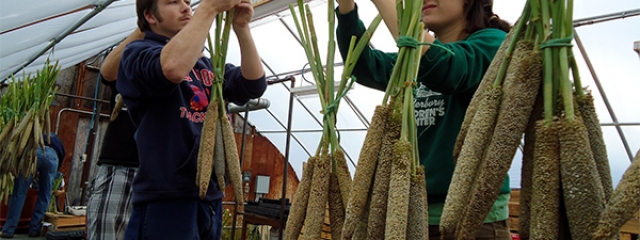Hampshire College President Jonathan Lash writes for the Huffington Post on how Hampshire educates for change in and outside of the classroom, including the food we eat on campus.
In my last post I promised to share some examples for reaching minds through food. Please indulge me on two points: I am of necessity using my own institution as a case study, as it’s work I can document. And I can only skim the surface, as these efforts are comprehensive, touching almost every aspect of life and learning on campus.
Consider this an invitation into a conversation, which I would like to see involve many different kinds of academic institutions and learners of all ages. The questions and goals are that large and, I believe, that important for the future.
Here are a few thoughts gleaned from Hampshire’s Healthy Food Transition:
Include students in decision-making. Encourage them to question food production and supply systems, and to envision solutions. Challenge them — and just as importantly, invite them to challenge you — to think in new and forward-looking ways.
From the moment we launched the Healthy Food Transition in 2012, students have been engaged in discussions around how to produce, prepare, consume and manage food on campus. This included selection of a food service provider that shares the social and environmental commitments of the campus community. Our students help us make choices that are educationally, ethically and financially sound.
Use food as a teaching tool. Professors working across disciplines develop courses that take full advantage of our food and farm resources. The farm is a location for courses in areas such as the arts and critical social inquiry as well as an obvious learning lab for the sciences. Each year a number of students complete impressive farm- and food-based independent projects.
Our dining commons also serves as a learning site. Information on nutrition is shared, there are demonstrations on healthy meal preparation, and discussions are held on topics such as food politics and food justice.
We’ve expanded academic programming on the farm to year-round, with a summer Food, Farm, and Sustainability Institute that attracts students from across the country and around the globe.
Promote health and wellness. Food produced and served in a manner students want can teach about nutrition and the connections between healthy eating and great taste, a healthy body and a healthy mind.
Involve students in producing as well as consuming food. Yes, as a pioneer in integrating the study and practice of sustainable farming and food systems into a liberal arts education, Hampshire has an advantage. But for students of all ages, and in all settings, somehow planting seeds in soil and watching them grow into food can be an opportunity for learning as well as satisfying at a fundamental level.
Build strong connections and partnerships. Meals are a community-building experience. Planning for meals to include faculty and staff draws more of them into our dining commons more frequently, promoting interactions with students and one another in an informal setting.
By purchasing food shares from local growers as well as from our own campus CSA, we contribute to the local and regional economy. Our intentionally provocative 100 percent Local Food Challenge commits us to food from within 150 miles of campus, except for unavailable items such as coffee or oranges.
We are fortunate to have alumni who are food entrepreneurs, food writers, farmers, scientists concerned with resource questions, and many more creative thinkers who support our work.
Take curriculum out into operations. Decisions based in a well-thought-out management model teach good stewardship. Students learn from putting ideas into action on the farm and in operational practices across campus. For example, menus in the dining commons are built around produce harvested on the College farm, offsetting some costs as well as providing fresh food for students throughout the year. We’ve produced a Sustainable Food Purchasing Guide. Buying local reduces expenses related to transportation, refrigeration, and packaging — and gives us the important bonus of reduced fossil fuel use.
This list is a sampling of actions taken on our campus, guided by our particular mission, values, and resources. I look forward to hearing from any readers who might offer other approaches in differing educational settings for how minds can be reached through food.






